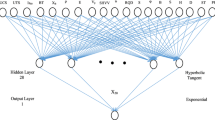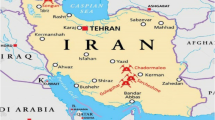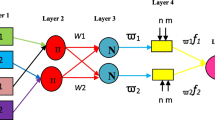Abstract
In the blasting operation, risk of facing with undesirable environmental phenomena such as ground vibration, air blast, and flyrock is very high. Blasting pattern should properly be designed to achieve better fragmentation to guarantee the successfulness of the process. A good fragmentation means that the explosive energy has been applied in a right direction. However, many studies indicate that only 20–30 % of the available energy is actually utilized for rock fragmentation. Involvement of various effective parameters has made the problem complicated, advocating application of new approaches such as artificial intelligence-based techniques. In this paper, artificial neural network (ANN) method is used to predict rock fragmentation in the blasting operation of the Sungun copper mine, Iran. The predictive model is developed using eight and three input and output parameters, respectively. Trying various types of the networks, it was found that a trained model with back-propagation algorithm having architecture 8-15-8-3 is the optimum network. Also, performance comparison of the ANN modeling with that of the statistical method was confirmed robustness of the neural networks to predict rock fragmentation in the blasting operation. Finally, sensitivity analysis showed that the most influential parameters on fragmentation are powder factor, burden, and bench height.





Similar content being viewed by others
References
Abbassi A, Bahar L (2005) Application of neural network for the modeling and control of evaporative condenser cooling load. Appl Therm Eng 25:3176–3186
Alsmadi MKS, Omar KB, Noah SA (2009) Back propagation algorithm: the best algorithm among the multi-layer perceptron algorithm. Int J Comput Sci Netw Secur 9:378–383
Anderson JA (1995) An introduction to neural networks. MIT, Cambridge, MA, pp 672. ISBN: 10:0262011441
Chauvin Y, Rumelhart DE (1995) Backpropagation: theory, architectures and applications. Erlbaum, Mahwah, NJ, p 561. ISBN 080581258X
Eberhart RC, Dobbins RW (1990) Neural network PC tools: a practical guide. Academic, San Diego, CA
Gokceoglu C, Zorlu K (2004) A fuzzy model to predict the uniaxial compressive strength and the modulus of elasticity of a problematic rock. Eng Appl Artif Intell 17:61–72
Gorucu FB, Ertekin T, Bromhal, G, Smith D, Sams N, Jikich S (2005) Development of a neuro-simulation tool for coal bed methane recovery and CO2 sequestration. International Coalbed Methane Symposium, Tuscaloosa. AL. Paper 0505
Grima A, Verhoef PNW (1999) Forecasting rock trencher performance using fuzzy logic. Int J Rock Mech Min Sci 36(4):413–432
Jong YH, Lee CI (2004) Influence of geological conditions on the powder factor for tunnel blasting. Int J Rock Mech Min Sci 41:533–538
Khandelwal M (2012) Prediction of safe charge to protect surrounding structures using support vector machine. Geotech Geol Eng 30(4):859–867
Khandelwal M, Kankar PK (2011) Prediction of blast-induced air overpressure using support vector machine. Arab J Geosci 4(3–4):427–433
Khandelwal M, Singh TN (2009) Prediction of blast-induced ground vibration using artificial neural network. Int J Rock Mech Min Sci 46:1214–1222
Khandelwal M, Singh TN (2011) Predicting elastic properties of schistose rocks from unconfined strength using intelligent approach. Arab J Geosci 4(3–4):435–442
Kosko B (1994) Neural networks and fuzzy systems: a dynamical systems approach to machine intelligence. New Delhi, Prentice-Hall, pp 12–17
Maerz NH, Franklin JA, Rothenburg L, Coursen DL (1986) Measurement of rock fragmentation by digital photoanalysis. Proceedings, Fifth International Congress International Society of Rock Mechanics. pp. 687–682
Monjezi M, Dehghani H (2008) Evaluation of effect of blasting pattern parameters on back break using neural networks. Int J Rock Mech Min Sci 45:1446–1453
Monjezi M, Yazdian A, Hesami SM (2006) Use of back propagation neural network to estimate burden in tunnel blasting. J Mines Metals Fuels 54:424–429
Monjezi M, Hesami SM, Khandelwal M (2011) Superiority of neural networks for pillar stress prediction in bord and pillar method. Arab J Geosci 4(5–6):845–853
Neaupane KM, Adhikari NR (2006) Prediction of tunneling-induced ground movement with the multi-layer perceptron. Int J Tunnel Undergr Space Technol 21:151–159
Neaupanea KM, Achet SH (2004) Use of backpropagation neural network for landslide monitoring, a case study in the higher Himalaya. J Eng Geol 74:213–226
Nie SL, Rustan A, (1987) Technique and procedures in analysing fragmentation after blasting by photographic method. Proceedings, Second International Symposium on Rock Fragmentation by Blasting, Keystone, Colorado, U. S. A. pp. 102–113
Peisheng L, Youhui X, Dunxi Y, Xuexin S (2005) Prediction of grindability with multivariable regression and neural network in Chinese coal. Fuel 84:2384–2388
Rumelhart D, Hinton G, Williams R (1986) Learning representations by backpropagating error. Nature 323:533–536
Simpson PK (1990) Artificial neural system: foundation, paradigm, application and implementations. Pergamon, New York
Tampe SS, Kulkarani BD, Deshpande PB (1996) Elements of artificial neural networks with selected applications in chemical engineering, and chemical & biological sciences, simulation & advanced controls. Louisville, KY
Tawadrous AS, Katsabanis PD (2006) Prediction of surface crown pillar stability using artificial neural networks. Int J Num Anal Methods Geomech 31:917–931
Trippi RR, Turban E (1996) Neural networks in finance and investing-using artificial intelligence to improve real-world performance. McGraw-Hill, New York, Revised ed
Wasserman PD (1989) Neural computing theory and practice. Van Nostrand Reinhold, New York
Yang Y, Zhang Q (1997) A hierarchical analysis for rock engineering using artificial neural networks. J Rock Mech Rock Eng 30:207–222
Author information
Authors and Affiliations
Corresponding author
Rights and permissions
About this article
Cite this article
Monjezi, M., Mohamadi, H.A., Barati, B. et al. Application of soft computing in predicting rock fragmentation to reduce environmental blasting side effects. Arab J Geosci 7, 505–511 (2014). https://doi.org/10.1007/s12517-012-0770-8
Received:
Accepted:
Published:
Issue Date:
DOI: https://doi.org/10.1007/s12517-012-0770-8




